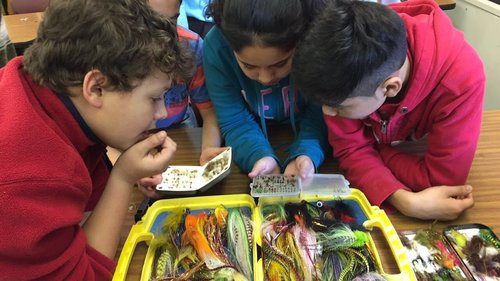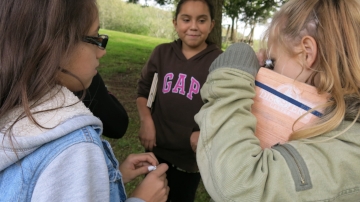

Learning about Amphibians & Aquatic Insects
BRDC has been busy with education programs, working with Galax Middle School, Fries School, Fairview Elementary, Grayson Highlands, Independence Elementary.
Grayson County's fourth grade students participated in the Natural Heritage Program with an emphasis on salamanders, toads, and frogs. Students learned about salamanders commonly found in the Blue Ridge.

Galax Middle School Studies Leaves, Invasive Plants and the American Chestnut
Students from Galax Middle School travel to Matthews State Forest to learn about the forests of the Blue Ridge.

Blue Ridge Illustrated: Oaks of Matthews State Forest
14 students spent two hours in the field defining the difference between the bark, acorns, leaves and tree structure of six species of oaks in the forest while effectively blocking out the myriad of other species in the forest. Their investigative efforts began the latest BRDC poster: The Oaks of Matthews State Forest.

Students conduct first survey of Deer Exclosure Plot
For our first research day, 9/9/15, the students focused on describing the forest floor and canopy densities, comparing percentages of herbaceous and rocky or barren coverage, taking a census of all the trees within an approximately 80 foot radius of the deer exclosure including diameter, height and species of each tree.

Seed Pods of Matthews State Forest by Galax High School Art Program
The Seed Pods of Matthews State Forest poster has been completed! It is the fourth in an ongoing series of posters from the Blue Ridge Illustrated program.

Mid April (2015) BRDC Program Notes
In spite of our fickle weather, which is certainly typical, we have managed to increase outdoor activities married to our principles and mission. As well, we continue through Bird Sleuth, to provide teachers with curricula (and moral) support.

Bio Survey, Matthew's State Forest, March 30th, 2015
At long last, the Southwest Virginia Home Educators returned for another fun-filled day of exploration and discovery at the Matthews State Forest. Twelve children of a wide age range and four moms joined Evan Worrell and me (Scott Jackson-Ricketts), BRDC guides, for a five hour plot investigation. We dedicated the morning to bird identification realizing quite a data set once the sun came out.

BRDC's Blue Ridge Expeditions Launches its First Foray
Blue Ridge Discovery Center is proud to welcome Roald Kirby to our team of naturalist explorers and guides. As program director of our new Blue Ridge Expeditions, Roald brings years of outdoor experience and love of our Blue Ridge to the public through a series of walks, guided hikes and nature lore.